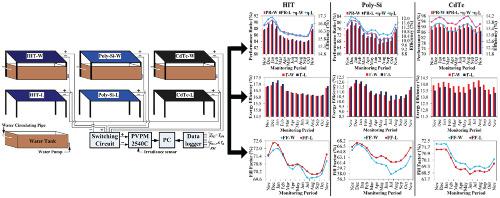当前位置:
X-MOL 学术
›
Prog. Photovoltaics
›
论文详情
Our official English website, www.x-mol.net, welcomes your
feedback! (Note: you will need to create a separate account there.)
Experimental characterization of the performance of different photovoltaic technologies on water bodies
Progress in Photovoltaics ( IF 8.0 ) Pub Date : 2019-11-05 , DOI: 10.1002/pip.3204 Manish Kumar 1 , Arun Kumar 1
Progress in Photovoltaics ( IF 8.0 ) Pub Date : 2019-11-05 , DOI: 10.1002/pip.3204 Manish Kumar 1 , Arun Kumar 1
Affiliation

|
Long term performance analysis of different PV technologies under the climatic condition of water bodies helps in the selection of appropriate PV technology for the large scale deployment on water bodies. The objective of the present research is to evaluate the suitability of different PV technologies on water bodies using performance and degradation analysis. Therefore, an experimental setup was designed to analyze the performance and degradation of HIT, Poly‐Si and CdTe PV technologies on the water surface and to compare their performance and degradation with the respective PV technologies deployed on the land surface. The data from experimental setup was measured for over one year duration. Furthermore, the evaporation reduction in PV panels covered water bodies has been experimentally measured. The performance of HIT and Poly‐Si PV panels on the water surface are found to be 0.4% and 2.7% lower than the corresponding land based panels, respectively; whereas the performance of CdTe panel on the water surface is found to be 3.1% higher than corresponding land based panel. The Poly‐Si panel has a degradation of 1.32% on the water surface which is significantly higher than the degradation rate of 0.93% of the corresponding land‐based panel whereas the HIT panels have almost similar degradation of approximately 0.50% in both climatic conditions. Thus, the study concludes that the HIT and CdTe technologies are suitable for water bodies applications. The experimental results show that the PV panel cover on the water bodies has reduced the evaporation loss by about 29% in one year.
中文翻译:

水上不同光伏技术性能的实验表征
在水体气候条件下对不同光伏技术的长期性能分析有助于为水体的大规模部署选择合适的光伏技术。本研究的目的是使用性能和降解分析来评估不同光伏技术在水体上的适用性。因此,设计了一个实验装置来分析HIT,多晶硅和CdTe光伏技术在水面上的性能和降解,并将其性能和降解与陆面部署的相应PV技术进行比较。实验设置中的数据经过一年以上的测量。此外,已经通过实验测量了覆盖光伏面板的水体中的蒸发减少。发现HIT和Poly-Si PV板在水面上的性能分别比相应的陆基板低0.4%和2.7%。而CdTe面板在水面上的性能要比相应的陆基面板高3.1%。多晶硅面板在水表面的降解率为1.32%,远高于相应陆基面板的0.93%的降解率,而HIT面板在两种气候条件下的降解率均接近0.50%。因此,研究得出的结论是HIT和CdTe技术适用于水体应用。实验结果表明,水体上的光伏面板盖在一年内将蒸发损失降低了约29%。分别比相应的陆基面板低7%;而CdTe面板在水面上的性能要比相应的陆基面板高3.1%。多晶硅面板在水表面的降解率为1.32%,远高于相应陆基面板的0.93%的降解率,而HIT面板在两种气候条件下的降解率均接近0.50%。因此,研究得出的结论是HIT和CdTe技术适用于水体应用。实验结果表明,水体上的光伏面板盖在一年内将蒸发损失降低了约29%。分别比相应的陆基面板低7%;而CdTe面板在水面上的性能要比相应的陆基面板高3.1%。多晶硅面板在水表面的降解率为1.32%,远高于相应陆基面板的0.93%的降解率,而HIT面板在两种气候条件下的降解率均接近0.50%。因此,研究得出的结论是HIT和CdTe技术适用于水体应用。实验结果表明,水体上的光伏面板盖在一年内将蒸发损失降低了约29%。比相应的陆基面板高1%。多晶硅面板在水表面的降解率为1.32%,远高于相应陆基面板的0.93%的降解率,而HIT面板在两种气候条件下的降解率均接近0.50%。因此,研究得出的结论是HIT和CdTe技术适用于水体应用。实验结果表明,水体上的光伏面板盖在一年内将蒸发损失降低了约29%。比相应的陆基面板高1%。多晶硅面板在水表面的降解率为1.32%,远高于相应陆基面板的0.93%的降解率,而HIT面板在两种气候条件下的降解率均接近0.50%。因此,研究得出的结论是HIT和CdTe技术适用于水体应用。实验结果表明,水体上的光伏面板盖在一年内将蒸发损失降低了约29%。该研究得出的结论是,HIT和CdTe技术适用于水体应用。实验结果表明,水体上的光伏面板盖在一年内将蒸发损失降低了约29%。该研究得出的结论是,HIT和CdTe技术适用于水体应用。实验结果表明,水体上的光伏面板盖在一年内将蒸发损失降低了约29%。
更新日期:2019-11-05
中文翻译:

水上不同光伏技术性能的实验表征
在水体气候条件下对不同光伏技术的长期性能分析有助于为水体的大规模部署选择合适的光伏技术。本研究的目的是使用性能和降解分析来评估不同光伏技术在水体上的适用性。因此,设计了一个实验装置来分析HIT,多晶硅和CdTe光伏技术在水面上的性能和降解,并将其性能和降解与陆面部署的相应PV技术进行比较。实验设置中的数据经过一年以上的测量。此外,已经通过实验测量了覆盖光伏面板的水体中的蒸发减少。发现HIT和Poly-Si PV板在水面上的性能分别比相应的陆基板低0.4%和2.7%。而CdTe面板在水面上的性能要比相应的陆基面板高3.1%。多晶硅面板在水表面的降解率为1.32%,远高于相应陆基面板的0.93%的降解率,而HIT面板在两种气候条件下的降解率均接近0.50%。因此,研究得出的结论是HIT和CdTe技术适用于水体应用。实验结果表明,水体上的光伏面板盖在一年内将蒸发损失降低了约29%。分别比相应的陆基面板低7%;而CdTe面板在水面上的性能要比相应的陆基面板高3.1%。多晶硅面板在水表面的降解率为1.32%,远高于相应陆基面板的0.93%的降解率,而HIT面板在两种气候条件下的降解率均接近0.50%。因此,研究得出的结论是HIT和CdTe技术适用于水体应用。实验结果表明,水体上的光伏面板盖在一年内将蒸发损失降低了约29%。分别比相应的陆基面板低7%;而CdTe面板在水面上的性能要比相应的陆基面板高3.1%。多晶硅面板在水表面的降解率为1.32%,远高于相应陆基面板的0.93%的降解率,而HIT面板在两种气候条件下的降解率均接近0.50%。因此,研究得出的结论是HIT和CdTe技术适用于水体应用。实验结果表明,水体上的光伏面板盖在一年内将蒸发损失降低了约29%。比相应的陆基面板高1%。多晶硅面板在水表面的降解率为1.32%,远高于相应陆基面板的0.93%的降解率,而HIT面板在两种气候条件下的降解率均接近0.50%。因此,研究得出的结论是HIT和CdTe技术适用于水体应用。实验结果表明,水体上的光伏面板盖在一年内将蒸发损失降低了约29%。比相应的陆基面板高1%。多晶硅面板在水表面的降解率为1.32%,远高于相应陆基面板的0.93%的降解率,而HIT面板在两种气候条件下的降解率均接近0.50%。因此,研究得出的结论是HIT和CdTe技术适用于水体应用。实验结果表明,水体上的光伏面板盖在一年内将蒸发损失降低了约29%。该研究得出的结论是,HIT和CdTe技术适用于水体应用。实验结果表明,水体上的光伏面板盖在一年内将蒸发损失降低了约29%。该研究得出的结论是,HIT和CdTe技术适用于水体应用。实验结果表明,水体上的光伏面板盖在一年内将蒸发损失降低了约29%。











































 京公网安备 11010802027423号
京公网安备 11010802027423号